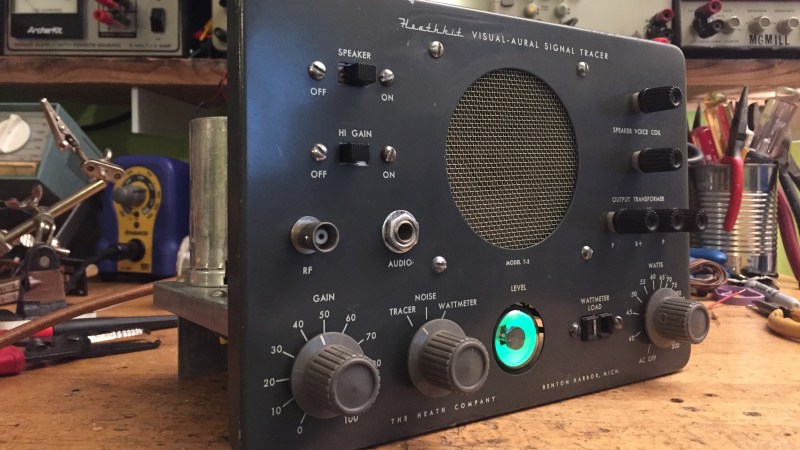In its heyday, the experience offered by the Heath Company was second to none. Every step of the way, from picking something out of the Heathkit catalog to unpacking all the parts to final assembly and testing, putting together a Heathkit project was as good as it got.
Sadly, those days are gone, and the few remaining unbuilt kits are firmly in the unobtanium realm. But that doesn’t mean you can’t tear down and completely rebuild a Heathkit project to get a little taste of what the original experience was like. [Paul Carbone] chose a T-3 Visual-Aural signal tracer, a common enough piece that’s easy to find on eBay at a price mere mortals can afford. His unit was in pretty good shape, especially for something that was probably built in the early 1960s. [Paul] decided that instead of the usual recapping, he’d go all the way and replace every component with fresh ones. That proved easier said than done; things have changed a lot in five decades, and resistors are a lot smaller than they used to be. Finding hookup wire to match the original was also challenging, as was disemboweling some of the electrolytic cans so they could be recapped. The finished product is beautiful, though — even the Magic Eye tube works — and [Paul] reports that the noise level is so low he wasn’t sure if turned it on at first.
We’ve covered the rise and fall of Heathkit, as well as their many attempted comebacks, including an inexplicable solder-free radio and the “world’s most reliable” clock. Looking at these offerings, we think [Paul] may be onto something here.















that’s a neat build and a nice writeup
Oh wow, I had used that same tracer for years going back to when I got my first Ham ticket back in the 70’s and it was well used then when I fount it at a Hamfest.
Built my first meter from a heath-kit, kit. It was a TVM at a meg ohm per volt. I was 15 at the time , my soldering skills were not the best , nor were my tools.
Worked great for years. About a year ago put together a digital oscilloscope. had to use a magnifying headset just to see the parts, good thing I am better at soldering than I was back then.
Nice job. I suspect that most of us of a certain age have built one or more Heathkits. I currently have maybe 6 or 7 Heathkit items of various vintage – half of which I built myself, and the rest ebay’d and in some cases repaired.
The experience of building a Heathkit was rewarding, and there’s pride in getting years of service from something you built and aligned yourself. But… they were expensive even back then, for what they were. They were a stepping-stone in an electronic education, not the final destination. So, fixing/upgrading – yes – but for me there would be no point in stripping/rebuilding a Heathkit just because.
I’m very much enjoying the current electronic landscape with the blend of very inexpensive building blocks, SBCs and modules, big support communities and libraries. And I’m still doing some work with discrete transistors – design, biasing, etc – but supported by active online communities. I would probably tear into an old Heathkit to update and improve it, not just to recreate the building experience.
Maybe in the US it was everyone, but not in the UK. I’ve seen two Heathkit devices ‘in person’ and once or twice picked up a catalogue, and it was very nice to look through and dream. They weren’t just expensive, rather, they definitely sat in the completely unaffordable exclusive luxury goods category, and then there was the complete impracticality of a personal import of anything from the USA.
Does anyone know if the old Heathkit manuals are available on the web anywhere? Last I heard the rights were purchased yet again and they were supposed to be placed in an open archive for everyone to access. Did this happen?
There are many at https://archive.org/details/heathkitmanuals?tab=collection
I have no idea if this collection is official or complete.
http://bama.edebris.com/manuals/ has all your manuals.
I think I have this sitting on a shelf somewhere. Found it perched on the edge of a dumpster behind a school maintenance facility. I guess someone just didn’t have the heart to throw it out, but didn’t really want to take it home either. I can’t recall what condition it’s in now. I think maybe the tube lit up last time I plugged it in? I think I also have a Heathkit signal generator, but I’m not sure it’s functioning any longer. One of them needed a special probe, which I do not have.
Foggy recollection is that Heathkit got its start with a 5″ recurrent–sweep ‘scope th;at took advantage of WW II surplus. I remember reading one ef its first ads, in Radio Craft (Gernsback) mag. I built and used sevurol kits. The company’s demise was really sad.
Fwiw, Korean War vet. here, saw no action. Pac. Fleet, ’55 to ’58; FTA2.